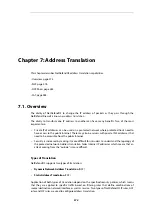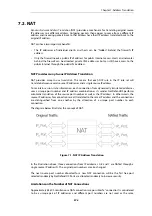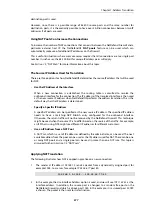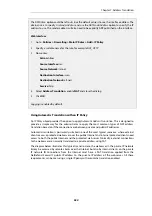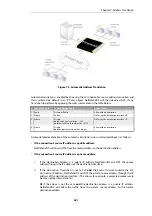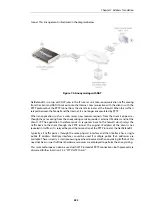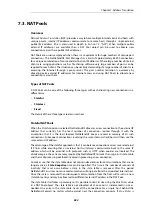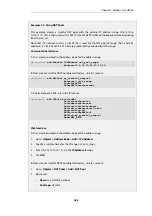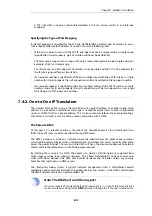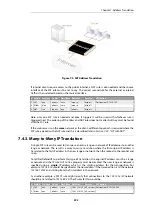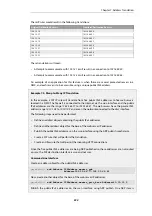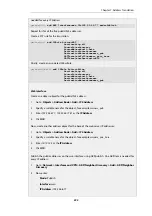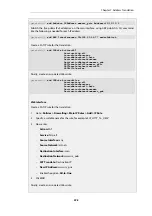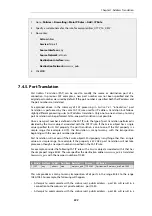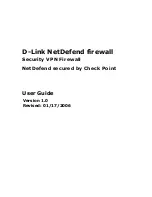
7.3. NAT Pools
Overview
Network Address Translation
(NAT) provides a way to have multiple internal clients and hosts with
unique private, internal IP addresses communicate to remote hosts through a single external
public IPv4 address (this is discussed in depth in
). When multiple public
external IP addresses are available then a
NAT Pool
object can be used to allocate new
connections across these public IPv4 addresses.
NAT Pools are usually employed when there is a requirement for huge numbers of unique port
connections. The NetDefendOS Port Manager has a limit of approximately 65,000 connections
for a unique combination of source and destination IP addresses. Where large number of internal
clients are using applications such as file sharing software, very large numbers of ports can be
required for each client. The situation can be similarly demanding if a large number of clients are
accessing the Internet through a proxy-server. The port number limitation is overcome by
allocating extra external IP addresses for Internet access and using NAT Pools to allocate new
connections across them.
Types of NAT Pools
A NAT Pool can be one of the following three types with each allocating new connections in a
different way:
•
Stateful
•
Stateless
•
Fixed
The details of these three types are discussed next.
Stateful NAT Pools
When the
Stateful
option is selected, NetDefendOS allocates a new connection to the external IP
address that currently has the least number of connections routed through it with the
assumption that it is the least loaded. NetDefendOS keeps a record in memory of all such
connections. Subsequent connections involving the same internal client/host will then use the
same external IP address.
The advantage of the stateful approach is that it can balance connections across several external
ISP links while ensuring that an external host will always communicate back to the same IP
address which will be essential with protocols such as HTTP when cookies are involved. The
disadvantage is the extra memory required by NetDefendOS to track the usage in its state table
and the small processing overhead involved in processing a new connection.
To make sure that the state table does not contain dead entries for communications that are no
longer active, a State Keepalive time can be specified. This time is the number of seconds of
inactivity that must occur before a state in the state table is removed. After this period
NetDefendOS assumes no more communication will originate from the associated internal host.
Once the state is removed then subsequent communication from the host will result in a new
state table entry and may be allocated to a different external IP address in the NAT Pool.
The state table itself takes up memory so it is possible to limit its size using the
Max States
value
in a NAT Pool object. The state table is not allocated all at once but is incremented in size as
needed. One entry in the state table tracks all the connections for a single host behind the
NetDefend Firewall no matter which external host the connection concerns. If
Max States
is
Chapter 7: Address Translation
584
Summary of Contents for NetDefendOS
Page 30: ...Figure 1 3 Packet Flow Schematic Part III Chapter 1 NetDefendOS Overview 30 ...
Page 32: ...Chapter 1 NetDefendOS Overview 32 ...
Page 144: ...Chapter 2 Management and Maintenance 144 ...
Page 284: ...Chapter 3 Fundamentals 284 ...
Page 392: ...Chapter 4 Routing 392 ...
Page 419: ... Host 2001 DB8 1 MAC 00 90 12 13 14 15 5 Click OK Chapter 5 DHCP Services 419 ...
Page 420: ...Chapter 5 DHCP Services 420 ...
Page 573: ...Chapter 6 Security Mechanisms 573 ...
Page 607: ...Chapter 7 Address Translation 607 ...
Page 666: ...Chapter 8 User Authentication 666 ...
Page 775: ...Chapter 9 VPN 775 ...
Page 819: ...Chapter 10 Traffic Management 819 ...
Page 842: ...Chapter 11 High Availability 842 ...
Page 866: ...Default Enabled Chapter 13 Advanced Settings 866 ...
Page 879: ...Chapter 13 Advanced Settings 879 ...





